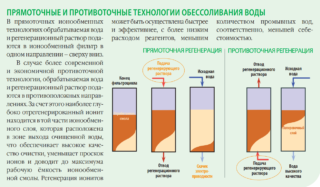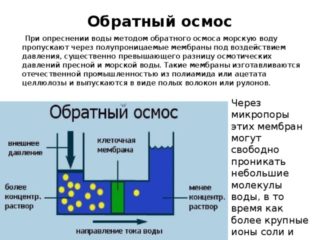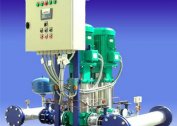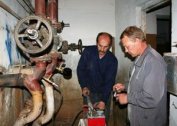Bringing indicators of tap water (borehole, well) to the optimum in terms of the amount of salt content is one of the main tasks of preparing a drinking resource. Otherwise, the liquid is not ready for use and causes irreparable harm to health, any technique. For high-quality processing of the source material, special water desalination plants are used. They differ in the way they act on the liquid.
Purpose and scope of the desalination method
Desalination is the process of qualitatively reducing the concentration of mineral impurities in a liquid medium to the values recommended by GOST and SanPiN. This indicator should not exceed 5 mg / l. Do not confuse the method of treating liquid with desalination (preparation of sea water).
Desalination is a reliable treatment method for the further use of liquids in the following industries:
- pharmaceutical industry;
- microelectronics;
- branches of medicine;
- chemical industry;
- power engineering;
- household, etc.
Methods of processing a liquid medium involve a change in the aggregate composition of water or its absence. Changes in the state of aggregation are methods of boiling, freezing for an hour or more, and distillation. They are more often used in everyday life. In the second case, electrodialysis, ion exchange, reverse osmosis are used.
Methods of desalting water
 The method of processing the liquid with an admixture of mineral salts is selected depending on the initial indicator for the concentration of impurities, the general capabilities of the master / industrial production, the feasibility of the cost of maintaining a particular installation.
The method of processing the liquid with an admixture of mineral salts is selected depending on the initial indicator for the concentration of impurities, the general capabilities of the master / industrial production, the feasibility of the cost of maintaining a particular installation.
Ion exchange
The principle of processing a liquid medium is to run it through special ion-exchange resins. In this case, the anions and cations of mineral impurities dissolved in the liquid are removed and replaced by ions of the filter material. With this method of desalination, it is possible to almost completely remove mineral dissolved impurities from the liquid medium.
The ion exchange installation is a reservoir filled with cartridges with filter material. Cassettes must be replaced regularly and the resin itself must be disposed of in a special way.
Reverse osmosis
 Installations often consist of several flasks filled with semipermeable synthetic membranes. The principle of desalting the liquid is that water under high pressure passes through the pores of the barrier. In this case, the membrane passes through itself only the molecules of the prepared medium, but not salts. For all other impurities, the barrier is impenetrable. Reverse osmosis plants remove dissolved salts and some gases: carbon dioxide, chlorine, etc. from the treated medium.
Installations often consist of several flasks filled with semipermeable synthetic membranes. The principle of desalting the liquid is that water under high pressure passes through the pores of the barrier. In this case, the membrane passes through itself only the molecules of the prepared medium, but not salts. For all other impurities, the barrier is impenetrable. Reverse osmosis plants remove dissolved salts and some gases: carbon dioxide, chlorine, etc. from the treated medium.
Electrochemical method
The essence of electrodialysis is that the aqueous medium is exposed to an electric field - it is passed through it. At this moment, the transfer of ions of dissolved salts occurs: anions are distributed to the anodes, cations - to the cathodes.
The electrodialysis unit has three chambers formed by the anode and cathode diaphragms. The middle compartment is the reservoir through which the fluid to be treated passes. A current is passed through it, which then divides the salt ions into cathodes and anodes.
Pros and cons of methods
 Each of the desalination methods has a number of advantages and disadvantages. Especially those who want to test methods for home use should take them into account.
Each of the desalination methods has a number of advantages and disadvantages. Especially those who want to test methods for home use should take them into account.
Ion-exchange installations differ in such advantages:
- getting the cleanest water possible;
- high reliability;
- lack of response to the degree of mineralization of the processed medium;
- low equipment costs.
The disadvantages of the ion exchange method include:
- the complexity of the disposal of waste filter material;
- environmental pollution;
- the need for regular filter changes.
The maintenance costs of the ion exchange system vary in proportion to the concentration of salts in the liquid.
For reverse osmosis installation, such advantages are characteristic:
- inertness to the initial composition of the liquid;
- ease of maintenance of the installation;
- no need to use complex reagents;
- the ability to dump spent concentrates into the sewer;
- high quality neutralization of mineral impurities;
- low system maintenance costs.
The disadvantages of reverse osmosis are:
- the need for pre-treatment of the liquid;
- high volume of discharges;
- the need for continuous operation of the installation;
- relatively high energy consumption at an industrial scale of treatment.
Reverse osmosis plants are mounted in private houses and apartments for a kitchen sink.
Electrolysis is not used in everyday life, since the cost of electricity and the installation itself are impractical.
More often at home, they use the thermal processing method (boiling) or filtering through carbon cartridges. However, this only softens the liquid, but does not eliminate mineral dissolved impurities.



